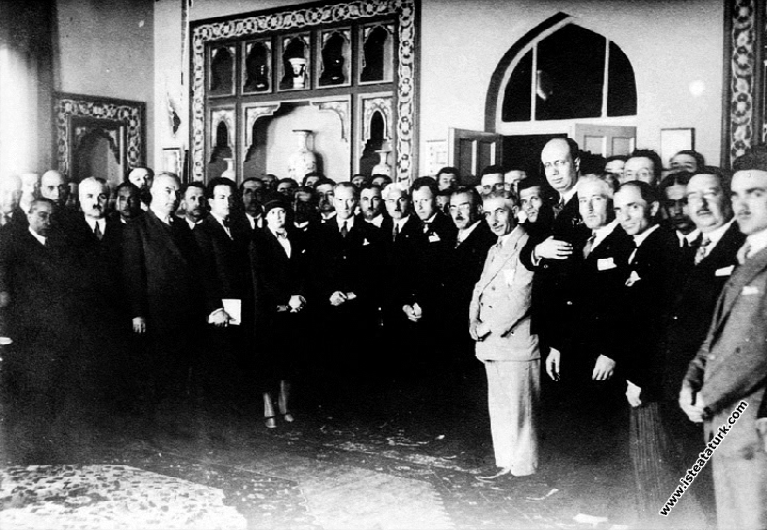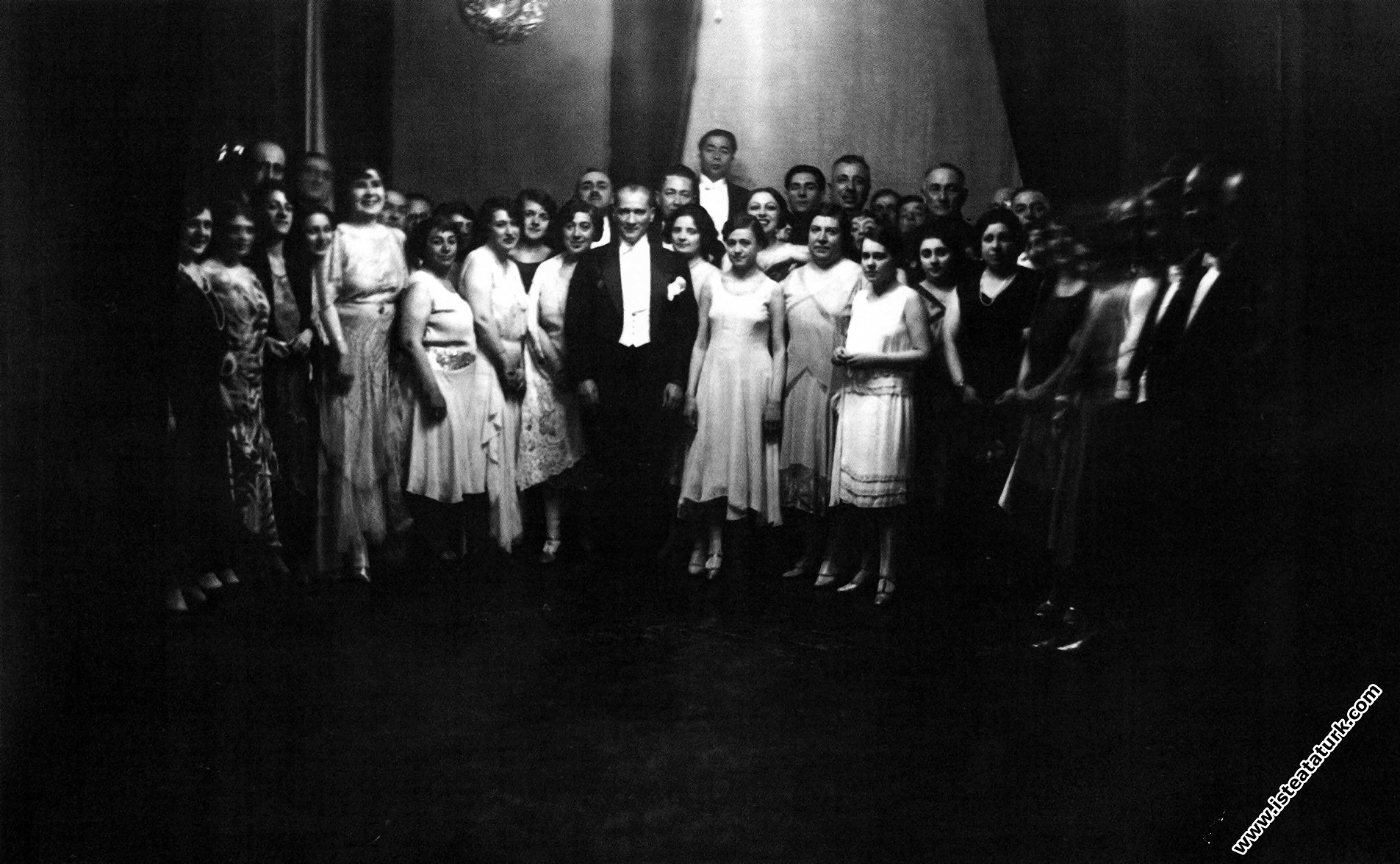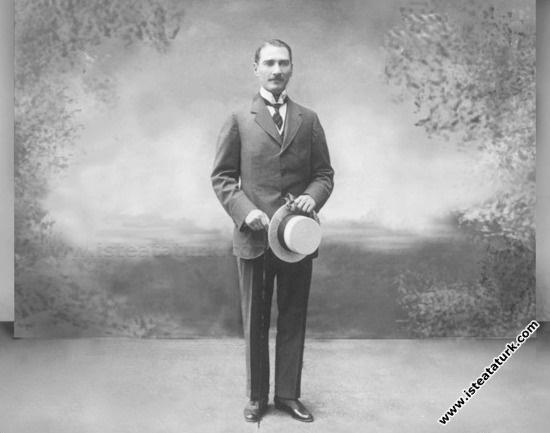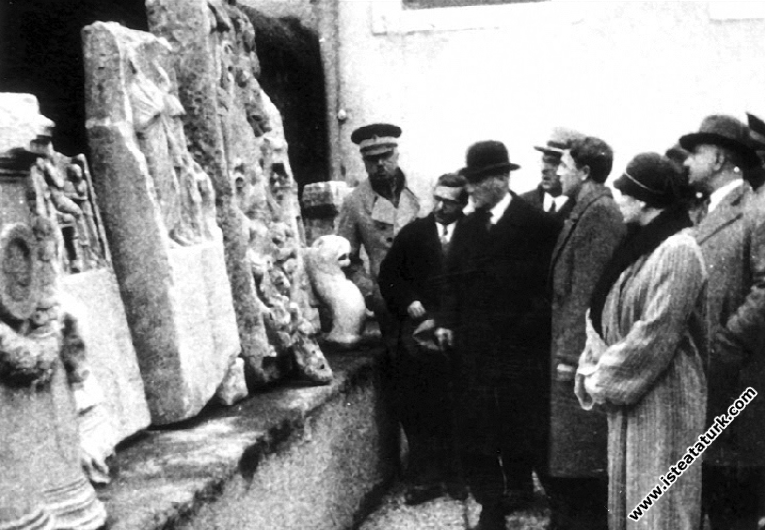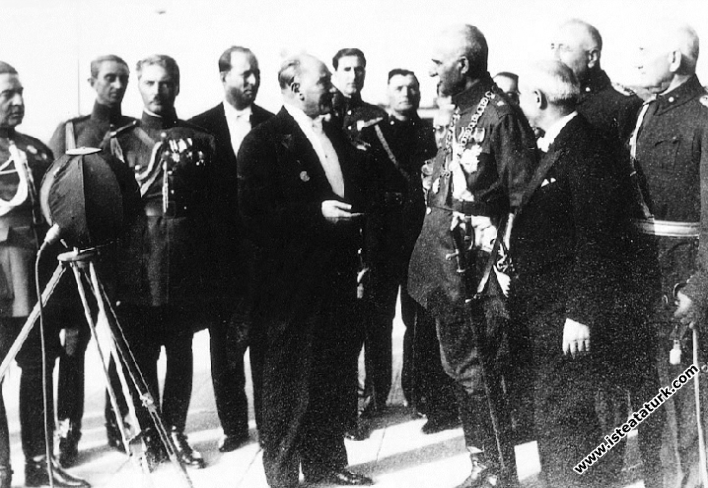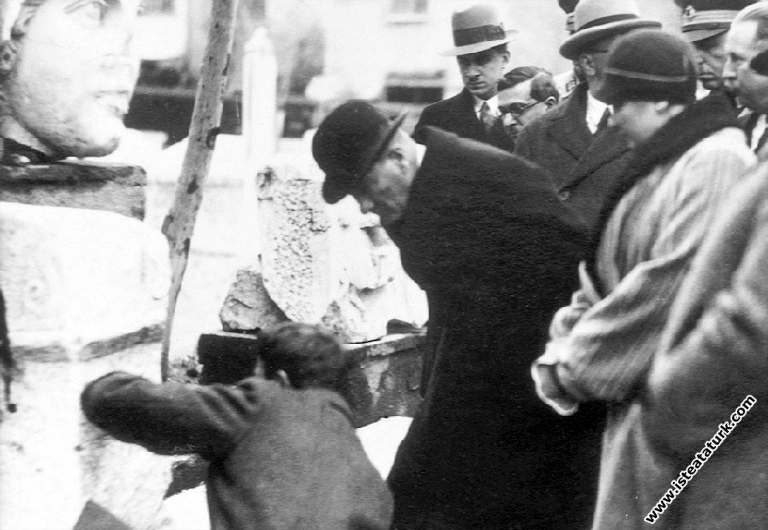
Museums and Atatürk
Character Size
Museums and Atatürk
MUSEUMS AND ATATURK
1 — During the National Struggle Years
Atatürk began to be interested in museums that store and exhibit the documents of national culture and national history since his student years. While at the Military Academy, he visited the Military Museum in Istanbul several times, and when he was the Military Attaché in Sofia, he attended a dress ball with the Janissary dress and weapons he had brought from the Military Museum. Dr. We learn from what Afet Inan told us. During his trip to Germany with Crown Prince Vahdettin in mid-December 1917, he stayed in Berlin for five days, while visiting the Potsdam Palace and Berlin museums. He later told the Museum Director Tahsin Öz how much the Pergamon Museum, where the Pergamon-Zeus temple was exhibited, had affected him. Atatürk, who opened the Grand National Assembly in Ankara at the beginning of the years of the National Struggle, in the first government that started work on May 9, 1920, He ordered the establishment of a Turkish Artifacts Directorate under the Ministry of National Education1. Considering that the central organization of the Ministry of National Education had a staff of only 20 people, apart from the Minister, at that time, it is better understood how much importance was attached to the Directorate of Asar-ı Atika, which had a staff of 1 director and a clerk, among the various services of education.
Asar-ı Atika Directorate was responsible for the protection of architectural works and ruins, as well as the supervision and administration of the Museum-i Hümâyûn branches that were opened in the provinces before. A year later, Asar-ı Atika Directorate transformed into the Hars (Culture) Directorate and enlarged its staff, and tasks related to libraries and fine arts were assigned to this department, along with ancient artifacts and museums.
During the months and years of the National Struggle, not much work could be done in the field of museology. However, the fear of destruction of ancient artifacts and looting of museums in the occupied regions and cities of Anatolia has been experienced very painfully. However, the country did not suffer much damage in this regard, but just after the Great Offensive, when the Greeks set Izmir on fire, the American Consulate placed the Sard excavation artifacts, which were preserved in the warehouses of Izmir High School, in 56 chests and sent them to the Metro Politan Museum in New York with a ship. . Immediately after the victory, the Director of Museums, Halil Ethem (Eldem), by the direct order of Atatürk, made drastic attempts to return the works, and after long correspondence, 53 boxes of antiquities were sent back to Turkey in June 1924, apart from 3 boxes of artifacts2.
Before the Great Offensive, there is another incident related to Atatürk and Turkish museology. Atatürk came to Konya on April 1, 1922, accompanied by Russian Ambassador Aralof and Azerbaijani Ambassador Abilof, and made investigations in Konya until April 4, 1922. On this trip, we see that Atatürk spent the day of April 3, 1922 with his guests to visit the Mevlana Lodge, the Konya Museum (Museum-i Hümâyûn Konya Branch), and the architectural works of the Seljuk and Ottoman periods in Konya. In the museum, Museum Director Naci Fikrtı (Baştak) gave information to Atatürk and answered Atatürk's questions. While visiting Konya's ancient monuments, he received information from Abdülkadir Erdoğan, who later became the Director of the Istanbul Museum of Turkish and Islamic Art3. While visiting the Seljuk Karatay Madrasa in Konya, he pointed to the falling tiles of the madrasah: “This building needs to be repaired. This is an amazing work of art. What a beautiful tile museum," he said. This recommendation of Atatürk was fulfilled years later, in 1955, when I was the Museum Director in Konya.
A few months after the victory, the Minister of National Education İsmail Safa published a circular with the title “Instruction on Museums and Asar-ı Atika” dated 5 November 1922 and sent it to the provinces4. In this circular, which is an important step for the future of Turkish museology, the duties and responsibilities of museum directors and civil servants are explained, and technical information is given on how to compile archeology and ethnology-related artifacts, and how to carry out inventory and conservation works. After a while, İsmail Safa, the Minister of National Education, established a Committee of Science to examine the problems of education and culture, by the order of Atatürk. In the work program of the Committee convened in Ankara on 15 July 1923; The establishment of a National Museum in Ankara and the immediate opening of the Turkish Ethnography Museum, There are also issues of reviewing the current Asar-ı Atika Regulation according to the new conditions. The scientific committee worked for a month and submitted its report to the Ministry5. In the days when these studies were carried out, the renewed government stated in the program read in the Turkish Grand National Assembly on August 14, 1923 that investigations will be started in various places by expanding and resupplying the Hars Directorate, national museums will be established in suitable centers, and the collection and examination of the national design will be studied.
2 — In the Republican Era
After founding the Republic, Atatürk once again emphasized the importance he attached to Turkish culture by saying: "The foundation of the Turkish Republic is culture, the Republic was founded on the rich Turkish national culture", and counted the museums as places where the material assets of Turkish culture are preserved and exhibited. Museum-i Hümâyûn, which is a State Museum, where archaeological artifacts are located in Istanbul until the Republic, and this museum has branches in the main cities of Anatolia, but most of them look like museum warehouses. In addition, a Evkaf Museum was opened in Istanbul in 1914. The Evkaf Museum, which will later be called the Museum of Turkish-Islamic Works, includes the works of the Islamic period. Topkapi Palace, which was given to the command of the Ottoman Treasury in Istanbul, and other Ottoman palaces, mansions and pavilions in Istanbul are like museums. are under protection with their belongings. However, Topkapı Palace is now abandoned and many parts of it are in ruins. The palace needs to be repaired without delay. Repair is not enough either. The day has come for his belongings to be preserved in the best way, and even to be exhibited in the repaired parts of the palace and opened to local and foreign visitors. Atatürk expressed this thought to the Prime Minister İsmet İnönü and the Minister of National Education Vasıf Çınar, and had a Council of Ministers Decision taken for the restoration, arrangement and opening of the Palace as a museum. The decree reads: even the day has come to be opened to local and foreign visitors by exhibiting in the repaired parts of the palace. Atatürk expressed this thought to the Prime Minister İsmet İnönü and the Minister of National Education Vasıf Çınar, and had a Council of Ministers Decision taken for the restoration, arrangement and opening of the Palace as a museum. The decree reads: even the day has come to be opened to local and foreign visitors by exhibiting in the repaired parts of the palace. Atatürk expressed this thought to the Prime Minister İsmet İnönü and the Minister of National Education Vasıf Çınar, and had a Council of Ministers Decision taken for the restoration, arrangement and opening of the Palace as a museum. The decree reads:
Republic of Turkey
power of attorney
Director of the Special Pen
Quantity:419
Decree
Topkapı Palace, which has been the scene of many historical events for centuries, which has been found to be of great value from the point of view of our national and historical architecture, and which must be preserved with its precious furnishings and outbuildings, is still for the zuvv that will come to Istanbul. Since it will of course constitute a main place of visit, the Ministry of Education has requested that these places be placed at the disposal of the Istanbul Âsâr-ı Atık Museum Director for the time being, in accordance with the Age of Atika Regulations, in order to ensure that they are preserved and conserved. The proposal of the Ministry of Hars with the bill numbered 4260/153 and the 3.4.In his meeting dated 340, ledettedkik was reminded that the aforementioned building belonged to the Museum so that the handover treatment would be carried out without fail, and the situation was notified to the Ministry of Internal Affairs and Finance by the proxy.
3.4.340
The President of the Republic of Turkey Gazi M. Kemal
İsmet, Deputy Prime Minister and Foreign Minister
Kazım, Deputy of the National Defense
Deputy Courthouse Mustafa Necati
Deputy Internal Affairs Ferit Deputy Finance Minister Mustafa Abdulhalik
Deputy of Education Vasıf Nafia Deputy “patient”
Agriculture Deputy
Trade Representative
Deputy Sıhhiye and Auxiliary Ictimaiyye Dr. Refik
Mahmut Celâl, Deputy Exchange, Reconstruction and Settlement
After this decree, Topkapı Palace was connected to the Ministry of National Education (Asar-ı Atika and Museums Department) to be opened to visitors as a museum, and its repair started immediately. The restoration of the palace, the inventory and display of its belongings took years. Atatürk came to the Topkapı Palace Museum, a part of which was opened to visitors in 1927, from time to time after this date and received information about the works from the Museums Director Halil Ethem Eldem. During a visit he made in the afternoon of 6 September 1929, he stayed in Topkapı Palace for more than 3 hours and saw the repairs on site6. The sultan's tents and sultanate tents set up in the second courtyard of the Topkapı Palace that day attracted the attention of Atatürk, and he examined the Nadir Shah Throne, known as the Shah Ismail Throne. Two days later, on September 8, 1929, Atatürk also visited the Hagia Sophia Mosque.
While work was being carried out in Topkapı Palace, on December 9, 1929, a museum expert found two maps drawn on gazelle skin, among documents that had not been tampered with for centuries. Examining the maps, Director of the Museums Halil Ethem Eldem realized that these were two maps that were not known until then, showing the coasts of Western Europe, Africa and East America in the years when the American continent was discovered, and that they were drawn in 1513 by the great Turkish sailor Pirî Reis. Atatürk was in Yalova in those days. Halil Ethem Eldem went to Yalova as he received the maps and showed them to Atatürk. Atatürk gave the order for this very important document to be published with a scientific examination8.
Atatürk's interest in the Topkapı Palace Museum and the works carried out continued until his death. On the afternoon of February 10, 1933, Atatürk, who came to the Topkapı Palace Museum accompanied by the Minister of Economy, Celal Bayar, visited the Treasury starting from the Mecidiye Mansion, then the Harem, and listened to the information given by the Museum Director Tahsin Öz. Atatürk, who stood for a long time on the weapons and 16th century Turkish helmets in the arms room, said that this room should be opened to visitors immediately9. At that time, the Minister of Education, Dr. Reşit Galip is in talks with a delegation of scientists and cultural figures about the establishment of a National Museum in Ankara on the site of the Roman Bath ruins on Çankırı street, as well as the opening of a National Library and a Turkish Sciences Academy. Atatürk gave the directive personally,
Atatürk visited Topkapı Palace several times in 1935 and 1936 and received information about the works from the Museum Director Tahsin Öz. During his visit on February 10, 1936, he stayed at Topkapı Palace for 3 hours11. Hagia Sophia, which was turned into a museum with the decision of the Council of Ministers on November 24, 1939, in the immediate vicinity of the Topkapi Palace Museum, and the Istanbul Archeology Museum, which is also next to the Topkapi Palace, made Sultanahmet the center of Istanbul museums. Again after the Republic, the Turkish and Islamic Arts Museum in Süleymaniye, which was previously managed under foundations, was attached to the Ministry of National Education.
After the Republic, Atatürk continued his interest not only with the museums of Istanbul, but also with the old city ruins and ruins in Anatolia, as well as museums.
According to our research, the first archaeological site he visited after the Republic was Ephesus. Atatürk, who came to Ayasuluğ (Ephesus) on his way on February 9, 1924 to open the Turkish Hearth in Söke, stayed here for a few hours and visited the ruins12. It was then that he learned that the Austrians had been conducting archaeological excavations here for years and that the Turks lacked the personnel to carry out such excavations. According to a report in the Hakimiyet-i Milliye Newspaper (Ankara) dated 11 August 1925, Atatürk examined the excavations in a turmulus near Ankara train station on site. In fact, in those days, Atatürk welcomed the proposal of the Minister of National Education, Hamdullah Suphi Tanrıöver, to build a National Museum in Ankara that exhibits Turkish and Islamic artifacts. This work was done by Hungarian Turcologist Dr. It was transferred to Meszaras and the construction of the museum was started. After the law on the closure of lodges, zawiyas and tombs dated 30 November 1925 came into force, some of the museum's lodge items were sent to Ankara and sorted. These items constituted the works of this first museum of the Republic, which would later be called the Ethnography Museum. The museum building was completed in 1928, Atatürk visited the museum on April 15, 1928 and ordered that the museum be ready for visit until the arrival of the Afghan King Amanullah Khan, who would visit Ankara on May 20, 192813. As a matter of fact, on May 25, 1925, the Afghan King had the museum opened.
After the decision to close the dervish lodges, zawiyas and tombs and to give the museum works related to history, art history and ethnography existing in these places to local museums, Atatürk granted a privilege to the Mevlana Tomb and Mevlevi Lodge in Konya, that this place should not be closed, but should be organized as a museum with its existing furniture and opened to visitors. wanted. After the publication of the Decree of the Council of Ministers, which declared that it should be turned into a museum due to the presence of works of art related to history and ethnography, the Director of Museums Dr. The delegation, headed by Hamit Z. Koşay, received Mevlana and the items in his lodge, and the Mevlana Museum was opened to visitors in 1927 under the name of Konya Asar-ı Atika Museum.
As we enter the 1930s, we see that Atatürk gave more importance than ever to historical and linguistic studies, cultural issues, meanwhile, archeology and museum issues. On March 9, 1930, when he was in Antalya, he visited the Antalya Museum, which was a museum warehouse. Representations can also be given here. In order to keep such historical artifacts alive, we must bring these artifacts to life in the direction of their purpose. There was also a liveliness in political life in those days. The Free Republican Party, founded by Fethi Okyar with the advice of Atatürk, won the support of the people. Fethi Okyar closed his party on November 16, 1936, after people who were not satisfied with the Republican People's Party caused confusion from time to time. Atatürk, being dissatisfied with the Republican People's Party, thought to examine and examine the socio-economic reasons of the interest and tendency of the people to the Free Republican Party, on the spot, and took a large research team with him on a country tour that lasted for more than 3 months on 17 November 1937. . During this trip, he visited the provinces of Kayseri, Sivas, Tokat, Amasya, Samsun, Trabzon, Istanbul, Kırklareli, Edirne, Bursa, as well as İzmir, Aydın, Denizli, Balıkesir, Antalya, Mersin, Adana, Konya, Afyon. I visited the Bursa Museum on January 5, 1931, and the İzmir Museum on February 3, 1931. In the museum book: I visited the İzmir Asar-ı Atika Museum. It has been made useful with great care and effort, and he has signed the words "I am pleased"16. He visited the Adana Museum on 17 February 1931 and came to Konya the next day.
3 — A New Era Begins in Turkish Museology
When Atatürk came to Konya, he visited the Mevlana Tomb and Dervish Lodge, which was turned into a museum at his own request, on February 21, 1931. Museum Director M. Yusuf (Akyurt) made extensive statements to Atatürk. He showed his wife one of the nomadic women's clothing that he had collected from the Konya region. Among the manuscripts in the museum, Atatürk focused mostly on translations of the Qur'an: “So our ancestors translated the Qur'an centuries ago and had it read. Why shouldn't we do it?" Atatürk, who spent more than three hours examining the museum, stated that he was satisfied with this visit, which he wrote in the museum notebook: "I am very pleased with the organization and order, which seems to be a work of knowledge."
After the museum, he visited the architectural works of the Seljuk and Ottoman periods in Konya and listened to the information given by N. Mes'ut Koman, a member of the Konya Asar-ı Atika Muhipleri Cemiyeti. However, these valuable documents of Turkish history and Turkish civilization, which could reach our revolution, are in ruins. Some are used as military warehouses. They must be immediately emptied and repaired; A telegram was sent to Tevfik Bıyıklıoğlu and Afet İnan, the Secretary General of the Presidency, who were dealing with the preparations for the establishment of the Turkish Historical Research Society (later the Turkish Historical Society) in those days, and they were asked to come to Konya. Tevfik Bıyıklıoğlu and Afet İnan, who came to Konya the next day, saw the ancient artifacts in Konya, and said that it was time to get involved in Turkish museology. They informed Atatürk that the old works in Konya should be repaired as soon as possible. On that very day, the following telegram was sent to Prime Minister İsmet İnönü, with Atatürk's signature, (Hurry and Important)17:
(Hurry and Important)
Konya: 19.2.11931
to the power of attorney
During my last study trip, I also reviewed museums and artifacts of antiquity and civilization in various places:
1 - Apart from Istanbul, I saw the existing museums in Bursa, Izmir, Antalya, Adana and Konya. Some of the works that have been found so far are preserved and partially classified with the help of foreign experts. However, in the future, we will bring to archeology specialists to be used in museum directorates and excavation works for the preservation and classification of ancient civilization artifacts, which are lying in the form of unmatched treasures almost all over our country, and for the preservation of monuments, which have become very devastated due to the constant neglect of the past periods. i are in need. For this reason, I think that a portion of the request, which will be sent to collection other than Education, will be appropriate to be allocated to this branch.
2 — There are some treasures in Konya that can be counted as genuine masterpieces of Turkish civilization eight centuries ago, despite the fact that they are in great ruin due to centuries of neglect. Especially Karatay Madrasa, Alaeddin Mosque, Owner-Ata madrasa, mosque and tomb, Sırçalı Masjid and İnce Minaret are in need of repair immediately and individually. Since the delay of this repair will lead to the complete destruction of these monuments, I request that the evacuation of those who are under military occupation and the repair of their cages under the supervision of special persons shall be ensured first.
“Gazi M. Kemal”
After this telegram, which started a new and advanced era in Turkish museology, students were sent to Europe for archeology education, the maintenance of the ancient artifacts left by the foundation administration was given to the Ministry of National Education, and the General Directorate of Antiquities and Museums was established. The Turkish Historical Research Society, which was founded on April 12, 1931, later this society turned into the Turkish Historical Society, the first History Congress was held in Ankara on July 2, 1932, and also the establishment of the Turkish Language Institute Atatürk himself completely history. and gains importance as the years he gives to language examinations. It is also considered to open a faculty in Ankara, which will train Turkish experts in all these fields.
After the First Turkish History Congress and Language Congress, Atatürk, who started to give more importance to the remains of the Eti (Hittite) civilization in Anatolia, visited the museum established in the Hunat Hatun Madrasa on February 5, 1934, while in Kayseri during a country trip, and visited the Hittite artifacts here. and on the Hittite tablets from Kültepe18. Atatürk wishes to have these artifacts found in the ruins in Anatolia be excavated by Turkish archaeologists. The Ahlatlıbel archaeological excavation near Yalıncak village in Ankara was carried out on Atatürk's orders, and Atatürk examined this excavation on site with the Minister of National Education, Ankara Governor and experts on 5 May 193519. The good results of this excavation encouraged Turkish archaeologists, General Director of Museums Dr. Hamit Zübeyr Kosay and Archaeologist Prof. Dr. A delegation headed by Remzi Oğuz, On August 21, 1935, they started a second and larger excavation in Çorum's Alacahöyük village with an allowance of one thousand liras. Towards the middle of September, on the last day of the excavation, the discovery of a golden crown, golden sword hilt, golden pitcher and cups, hair pins and many other valuables from the tomb of the Great King created great excitement. shown. Atatürk ordered the continuation of excavations in Alaca and the establishment of an Eti (Hittite) Museum in Ankara. The five thousand-year-old material Turkish history documents that have been extracted are of a nature to re-examine and confirm the history of world culture...”20. That year,
A Painting and Sculpture Museum was created in the Istanbul-Dolmabahçe Palace Crown Prince's office, with the importance Atatürk attached to fine arts, in the meantime, to the art of painting and sculpture. The museum was opened by Atatürk on September 20, 1937, and the Director of the Museum, Painter Halil Dikmen, informed Atatürk about the artifacts that day. Atatürk came to Adana on May 19, 1938, while he was in his sick bed, when he was persistently dealing with the Hatay Issue, and stopped by Mersin. Even in this situation, he could not help seeing the ruins of Viranşehir (Pompeipolis) near Mersin21. He said that he was dealing with ancient artifacts and museums when he was sick. Dr. Afet Inan writes the following in his memoirs: “... When I told him about the artifacts from the Thrace tumuli during his illness in 1938, he showed interest and had some of them brought from the museum. One of them, in particular, depicting one of the stories of Laspanaine, I think, II. He liked a vase with a picture of a fox and a stork, dating back to the 16th century”22.
4 — Conclusion
In conclusion, we can say that with the importance Atatürk gave to Turkish culture, Turkish history and art, Atatürk showed great interest in museums where material documents of history and culture were collected and exhibited, and he personally ensured the establishment of many. Conservation and repair of old historical buildings, initiation of national archaeological excavations in Anatolia, training of museum and history experts, opening of faculties to train them, scientific research of Turkish history and Turkish language, and establishment of institutions to carry out these are works of Atatürk's close interest and love.
Ankara Ethnography Museum, where Atatürk was interested in all kinds of works from planning to construction, was happy to host Atatürk in his heart for 15 years until he was taken to Anıtkabir after his death. Today, the following inscription engraved on marble is read in the inner courtyard of the museum: This is the place where Atatürk, who reached eternity on November 10, 1938, slept from November 21, 1938 to November 10, 1953. Turkish museums and museums tried to repay their debts of gratitude and gratitude to him by embracing Atatürk.
1 Kazım Öztürk, Governments and Programs of the Republic of Turkey, p. 15, Ankara,
2 Halil Ethem Eldem, Memoir, Ankara, 1953.
3 Babalık (Konya) Newspaper, dated April 4, 1922.
4 Remzi Oğuz Arık, A Look at Turkish Museology, p. 43, Istanbul, 1953.
5 Hasan-Ali Yücel, Secondary Education in Turkey, p. 16, Ankara, 1938.
Cumhuriyet (Istanbul) Newspaper, dated 6 7 September 1929.
7 (Istanbul) Cumhuriyet Newspaper, dated September 9, 1929.
8 Mehmet Önder, The Museums of Turkey, p. 239, Ankara, 1983.
9 Cumhuriyet ve Vakit (Istanbul) Newspaper dated 11 February
10 From the same newspapers.
11 From the same newspapers.
12 Journal of Hakimiyet-i Milliye (Ankara) dated 10 February 1924
13 Hamit Zubeyr Kosay, Ethnography Museum Guide, p. 4, Ankara, 1956.
14 Hakimiyet-i Milliye (Ankara) Newspaper, dated 7 February 1930.
15 Cumhuriyet (Istanbul) Newspaper, dated 10 March 1930.
16 Utkan Kocatürk, After Writing in Atatürk's Memoirs, p. 15, Ankara, 1971.
17 For More Information: Mehmet Önder, Atatürk in Konya, Ankara, 1989.
18 Ömer Çelebi, Atatürk in Kayseri, p. 102, Ankara, 1973.
19 Cumhuriyet (Istanbul) Newspaper dated 6 May 1935
20 Minutes of the Grand National Assembly of Turkey, Circuit: 5, volume: 13.21
Ulus Newspaper dated 21-24 May 1938
22 Prof. Dr. Afet Inan, Archeology Studies in the Age of Ataturk, From History to Today, p. 187, Ankara, 1970.
Dr. Mehmet Önder
Source: ATATÜRK ARAŞTIRMA MERKEZİ DERGİSİ, Sayı 16, Cilt VI, Kasım 1989
